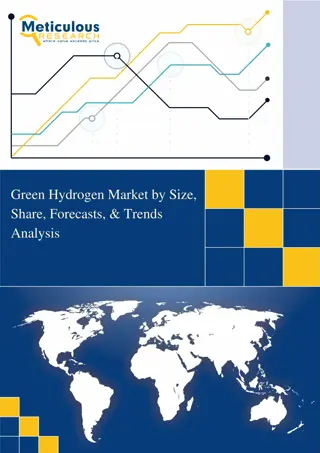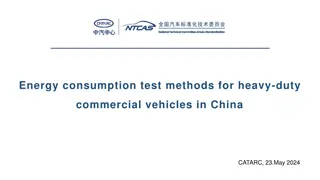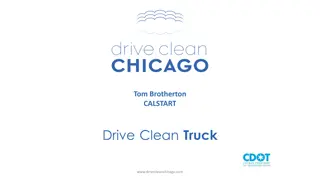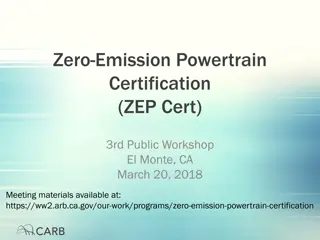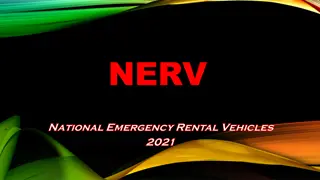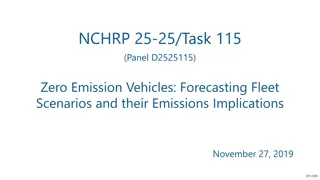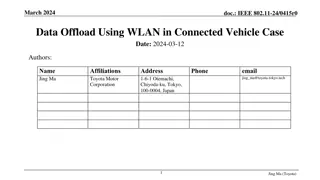Feasibility of 100% Zero Emission Vehicles in Illinois by 2035
The feasibility of transitioning to 100% zero-emission vehicles in Illinois by 2035 powered solely by renewable energy sources. Analysis includes energy demand, savings, constraints, and the Zero Emission Vehicle program. Strategies for achieving a sustainable transportation system are discussed, focusing on electric vehicles and reducing carbon emissions. The goal is to make all new cars electric by 2035 and increase public transit usage by 2030."
Download Presentation

Please find below an Image/Link to download the presentation.
The content on the website is provided AS IS for your information and personal use only. It may not be sold, licensed, or shared on other websites without obtaining consent from the author.If you encounter any issues during the download, it is possible that the publisher has removed the file from their server.
You are allowed to download the files provided on this website for personal or commercial use, subject to the condition that they are used lawfully. All files are the property of their respective owners.
The content on the website is provided AS IS for your information and personal use only. It may not be sold, licensed, or shared on other websites without obtaining consent from the author.
E N D
Presentation Transcript
Feasibility of 100% Zero Emission Vehicles by 2035 in Illinois Powered by Renewable Energy Sources Only Sonia Chandra UIUC M.Eng in Energy Systems schand58@illinois.edu NPRE 498
Background 5th largest energy-consuming state in the nation 6th largest petroleum- consuming state in the nation 1,014 trillion BTU annually $21,260 million annually
Background Destination: Zero Carbon I. Make all new cars electric by 2035. II. Make all buses electric by 2030. III. Double the number of people who travel on foot, bike or public transit by 2030.
Types of Electric Vehicless(EVs) Plug-in hybrid Battery electric Hydrogen fuel cell
Zero Emission Vehicle (ZEV) program Managed by California Air Resources Board (CARB) Adopted by 10 states: Colorado, Connecticut, Maine, Maryland, Massachusetts, New Jersey, New York, Oregon, Rhode Island, and Vermont Each automaker is assigned ZEV credits Tesla Model S : 3.3 credits Nissan Leaf: 1.8 credits PHEVs 43% of credits BEVs & FCEVs 57% of credits
Constraints Total Energy Demand: 100% EV s Renewable Energy Sources: Nuclear, Wind and Solar Business As Usual (BAU) Projections Feasibility: I. Growth in Renewable Energy > Total Energy Demand II. Current grid system can supply and transmit total energy demand III. Savings from petroleum > Cost of infrastructure (4 charging ports to80% current gas stations)
Energy Demand from 100% EVs Total Miles Driven in IL / Year Average car (ICE) fuel consumption= 25mpg Illinois motor gasoline consumption (2019) = 105,720,000 Barrels Total miles travelled in IL/ year (2019) =1.1 x10^11 miles (110 Billion Miles) Average miles per driver = 12,581 miles Current % of EV s in IL = 0.3 % (12400) Total Energy Demand Average EV energy consumption=314Wh/mile Total Energy Demand (100%)= 1.1 x 10^11 miles x 314Wh/mile 35 TWh
Energy Savings from 100% EVs Current Energy Demand (gasoline) = 180 TWh 145 TWh savings Energy Savings 180TWh 35TWh = 80%
Feasibility on IL Grid System Current net electricity generation = 184TWh Total Retail Sales = 138TWh Energy not consumed = 46TWh (25%) Additional energy needed = 35 TWh
Anticipated Renewable Energy Generation in 2035 Source (Thousand MWh) Nuclear Wind Solar Total 74 TWh 47% Powering EV s Current Generation (2020) 100246 17111 92.85 Expected Generation (2035) 105356 86486 185.5 Additional Energy 5110 69375 92.65 74577.65
Nuclear Power in Illinois Without nuclear energy: 69TWh 51% Powering EV s
Solar Energy in IL SEIA: Path to 100 RPS: 25% by 2025 to 40% by 2030 REC procurement from 10 million by 2020 to 45 million by 2030 50/50 split from solar and wind.
Residential PV Expected to grow 1700% in next decade Residential PV 1400 MWh 2TWh
Cost of Infrastructure AC Level 2 Vehicle Range Added per Charging Time and Power 10 mi/hour @ 3.4kW 20 mi/hour @ 6.6kW 60 mi/hour @ 19.2 kW 208/240VAC/20-100A (16-80A continuous) EVSE Cost Installation $4200 Pedestal Equipment $4500 Operation & Maintenance $686 Total $9386
Cost of Infrastructure Number of charging ports Total Cost =12,212 = $114.6 Million Cost of petroleum/year =$4.6 Billion
Benefits of EV Market Expansion on Energy Storage Systems Allows EV s to be used in lieu or in conjunction with electricity storage in emergencies/supply shortages As EV increases amount of energy purchased at night, it reduces energy-time shift and time-off use energy cost management Leads to economies of scale and lower prices for advanced battery systems Increases grid integration and system management
EV exemption from state emissions testing Current EV Incentives ComEd offers 3 EV rate plans for residential customers Illinois Electric Co-op members may be eligible to finance their EV at 0.5% interest City of Naperville offers $30 per kW up to $3,000 (filed on behalf of customer)
EU Electric Vehicle Targets 30 million electric cars by 2030 Currently: 1.8 million electric and plug-in hybrid vehicles registered in Europe High-speed rail traffic to double by 2030 Scheduled travel between cities of under 300 kilometers (186 miles) to become carbon-neutral Zero-emission large aircraft and vessels should be ready for market by 2035
Questions? Thank You
References https://ev-database.org/cheatsheet/energy-consumption-electric-car https://www.iea.org/reports/fuel-consumption-of-cars-and-vans https://www.epa.gov/automotive-trends/highlights-automotive-trends-report https://afdc.energy.gov/data/10962 https://www.thezebra.com/resources/driving/average-miles-driven-per-year/#average-miles-driven-per-year- by-state https://www.valuepenguin.com/auto-insurance/car-ownership-statistics https://www.solarpowerworldonline.com/2019/06/illinois-agency-says-state-wont-reach-rps-of-25-by-2025- unless-legislation-changes/ https://ilenviro.org/energy/renewable-energy/ https://afdc.energy.gov/files/u/publication/evse_cost_report_2015.pdf
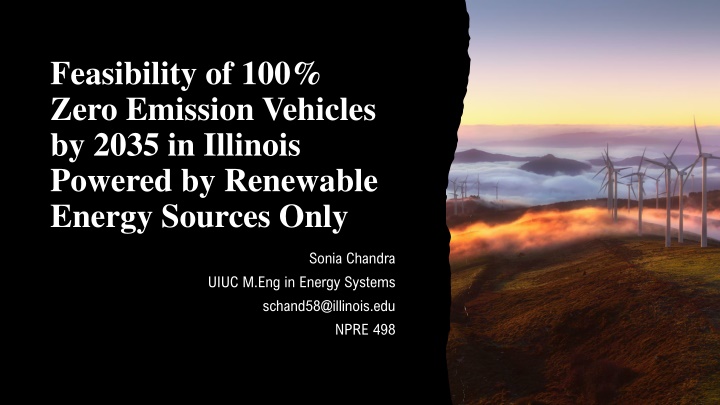

![Long-Range Wireless Charging Market Report & Analysis _ BIS Research [2024-2035]](/thumb/87166/long-range-wireless-charging-market-report-analysis-bis-research-2024-2035.jpg)
